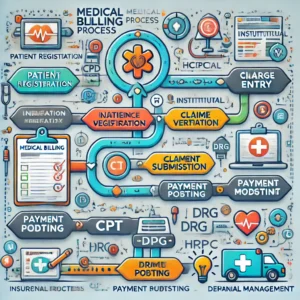
Medical billing is a critical component of the healthcare industry, ensuring that healthcare providers are reimbursed for their services. It is a complex and multi-step process that involves the submission and management of claims to health insurance companies, which are responsible for covering the costs of medical services. In this article, we’ll delve into the key aspects of medical billing, including its core steps, types of billing, billing codes, and the different billing systems used by healthcare providers.
What is Medical Billing?
Medical billing is the process through which healthcare providers and facilities submit claims to insurance companies for payment. This process requires the accurate coding of medical services and diagnoses to ensure that the healthcare provider is appropriately reimbursed for the services rendered. It acts as a bridge between the healthcare provider, the insurance company, and the patient, ensuring that payments are made correctly and efficiently.
Key Steps in the Medical Billing Process
The medical billing process involves several crucial steps that ensure claims are processed and payments are collected. These steps include:
- Patient Registration: The process begins when a patient registers for a visit. This involves collecting the patient’s personal and insurance information.
- Insurance Verification: Before services are provided, the healthcare provider verifies the patient’s insurance coverage, co-pays, and deductibles to avoid surprises later.
- Charge Entry: The healthcare provider assigns appropriate codes to represent the services rendered and diagnoses given during the visit.
- Claim Submission: Once the services are coded, the claim is submitted to the insurance company, either electronically or via paper forms.
- Adjudication: The insurance company reviews the claim, determines the amount covered, and processes the payment accordingly.
- Payment Posting: Once the insurance company pays its portion, the payment is recorded, and the balance is posted to the patient’s account.
- Denial Management: If a claim is denied or rejected, the medical billing team must address the issue, correct errors, and resubmit the claim.
- Patient Billing: If there is a remaining balance after insurance, the patient is billed for the amount due, which may include co-pays, deductibles, or uncovered services.
- Collections: The final step involves following up on outstanding payments from either the insurance company or the patient, ensuring that the healthcare provider is fully reimbursed.
Types of Medical Billing
Medical billing can be categorized into two main types, depending on the nature of the services and where they are provided:
- Professional Billing: This type of billing is used by individual healthcare providers, such as doctors, to bill for outpatient services. It focuses on services rendered by professionals in clinics or private practices.
- Institutional Billing: This is used for billing hospital or facility-based services, such as inpatient treatments, surgeries, diagnostics, and emergency room care. Institutional billing involves more complex processes and larger volumes of claims.
Types of Billing Codes
Medical billing relies heavily on accurate coding to ensure that services and diagnoses are properly represented in claims. The primary types of billing codes include:
- ICD (International Classification of Diseases): These codes represent patient diagnoses. They provide standardized descriptions of diseases, conditions, and injuries.
- CPT (Current Procedural Terminology): These codes describe the procedures, services, and medical interventions performed by healthcare providers.
- HCPCS (Healthcare Common Procedure Coding System): These codes are used for billing items, services, and procedures not covered by CPT, including durable medical equipment, prosthetics, and certain medications.
- DRG (Diagnosis-Related Group): These codes are used by hospitals for inpatient services. They categorize hospitalization costs and reimbursements based on a diagnosis and the treatment provided.
Types of Medical Billing Systems
To manage the entire billing process effectively, healthcare providers use different types of billing systems. The choice of system depends on the nature of the healthcare organization and its specific billing needs. Below are the main types of billing systems:
1. Open Medical Billing System
- Definition: An open system allows multiple healthcare providers or facilities to access and update a patient’s medical and billing information.
- Usage: This type of system is used when patients are treated by multiple providers, such as specialists, labs, or hospitals, ensuring a seamless exchange of medical and billing data.
- Advantages:
- Facilitates better care coordination across providers.
- Enhances transparency and reduces data duplication.
- Challenges:
- Multiple access points raise security concerns.
- Integration between various systems can be complex and expensive.
2. Closed Medical Billing System
- Definition: In this system, a patient’s medical and billing information is stored within a single healthcare provider or facility, and external access is restricted.
- Usage: Closed systems are common in smaller practices or organizations where the patient’s care is primarily managed by a single provider.
- Advantages:
- Greater control over data privacy and security.
- Simpler billing process since all services are handled internally.
- Challenges:
- Lack of interoperability with other systems, which can make it difficult to share records when necessary.
3. Isolated Medical Billing System
- Definition: This system focuses solely on billing and does not integrate with patient care data.
- Usage: Typically used by third-party billing companies or by in-house billing departments that focus on claims management rather than clinical care.
- Advantages:
- Provides dedicated focus on accurate and efficient billing processes.
- Challenges:
- The lack of integration with clinical data can create communication gaps between the billing and healthcare teams.
Conclusion
Medical billing is a multi-faceted process that requires precision and coordination across healthcare providers, insurance companies, and billing teams. With various types of billing systems and codes, it’s crucial for healthcare providers to choose the right system that aligns with their operational needs and the complexity of their services. Accurate and efficient medical billing ensures that providers are reimbursed, patients receive proper care, and the overall healthcare system runs smoothly. Understanding these systems, steps, and codes is essential for anyone involved in medical billing or healthcare administration.
